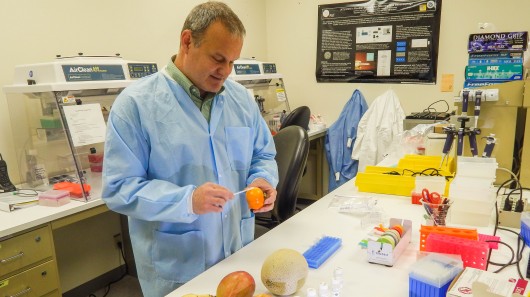
According to the US Center for Disease Control (CDC), 129,000 Americans are sent to hospital and 3,000 die each year from food poisoning. Currently, tracing contaminated food is largely a matter of record keeping and detective work, but Lawrence Livermore National Laboratory (LLNL) researchers, in partnership with DNATrek, have developed DNATrax, a DNA-based additive for directly tracking food from producer to consumer.
Food poisoning due to outbreaks is a major problem, putting thousands of lives at risk, wasting tons of recalled foodstuffs, with US$70 billion dollars lost in the US alone each year. The problem is that current methods of tracing outbreaks are inefficient, time consuming and imprecise because they rely on what is essentially a combination of accountancy, interviews, and logical deduction to trace contaminated foods back along what is often an incomplete trail. That's where DNATrax comes in
Originally designed for bio-defense work, DNATrax was created as a way to simulate germ warfare attacks on indoor and outdoor targets. The conventional way of determining the weak spots in targets ranging from underground rail systems to the Pentagon is to spray harmless bacteria into the air, later collect samples from various places, then incubate them to see how the bacteria has spread. With DNATrax, the bacteria is replaced by particles of non-biological DNA that can be collected with simple forensic swabs and then subjected to DNA analysis. The application of food tracking was an unexpected bonus.
DNATrax is surprisingly simple. It's an odorless, tasteless substance that's classified as a harmless food additive by the US Food and Drug Administration. It's made of strands of non-living and non-viable DNA encased in sugars similar to common icing sugar. These strands, like all DNA, can record information and have 1060 variations, so they can contain a lot of data that, according to LLNL, acts like "an invisible barcode."
Applying DNATrax is simply a matter of spraying it on fruits, vegetables and meats, or mixing it in with bulk commodities like honey, olive oil, flour, or rice. The idea is to use the DNA to record a code sequence with data such as what the product is, where it came from, when it was harvested and so on. Then simple polymerase chain reaction (PCR) technology can identify the code and reveal the origin of the product in about an hour, right down to which tree a particular apple came from.
Aside from tracking down contaminated food, LLNL says that DNATrax can also help combat food piracy. Most people have heard of movie or music piracy and may have come across a dodgy "Rolex" down the market, but piracy is actually a major problem for almost all commerce – including food. Called wastage, grocery shelves are constantly invaded by everything from fake corn flakes to counterfeit honey selling under false labels, to adulterated wines and olive oils mixing the premium with the cheap stuff. Since such label swapping and adulteration does not occur where the food is produced, but somewhere down the line, DNATrax can identify fraudulent foods as well as how many adulterants have been added, how much, and where they came from.
Another application that LLNL is looking at is protective clothing. With the current Ebola outbreak, tracking contamination in anti-contamination suits is vital, so the researchers see DNATrax as a safe way of assessing how well current suits are performing. By applying the DNA particles to the exterior of the suit, it is possible to identify if a breach has occurred by seeing if contaminants appear on the wearer's skin.
“We all hear horror stories about contaminated foods,” says DNATrek CEO Anthony Zografos. “We are not prepared to deal with an outbreak of pathogens such as E. coli and salmonella in tainted foods. However, DNATrax is a quick and efficient way to stop these foods from sickening more people and costing producers more money due to massive recalls triggered by poor traceability.”

 Previous page
Previous page Back to top
Back to top







